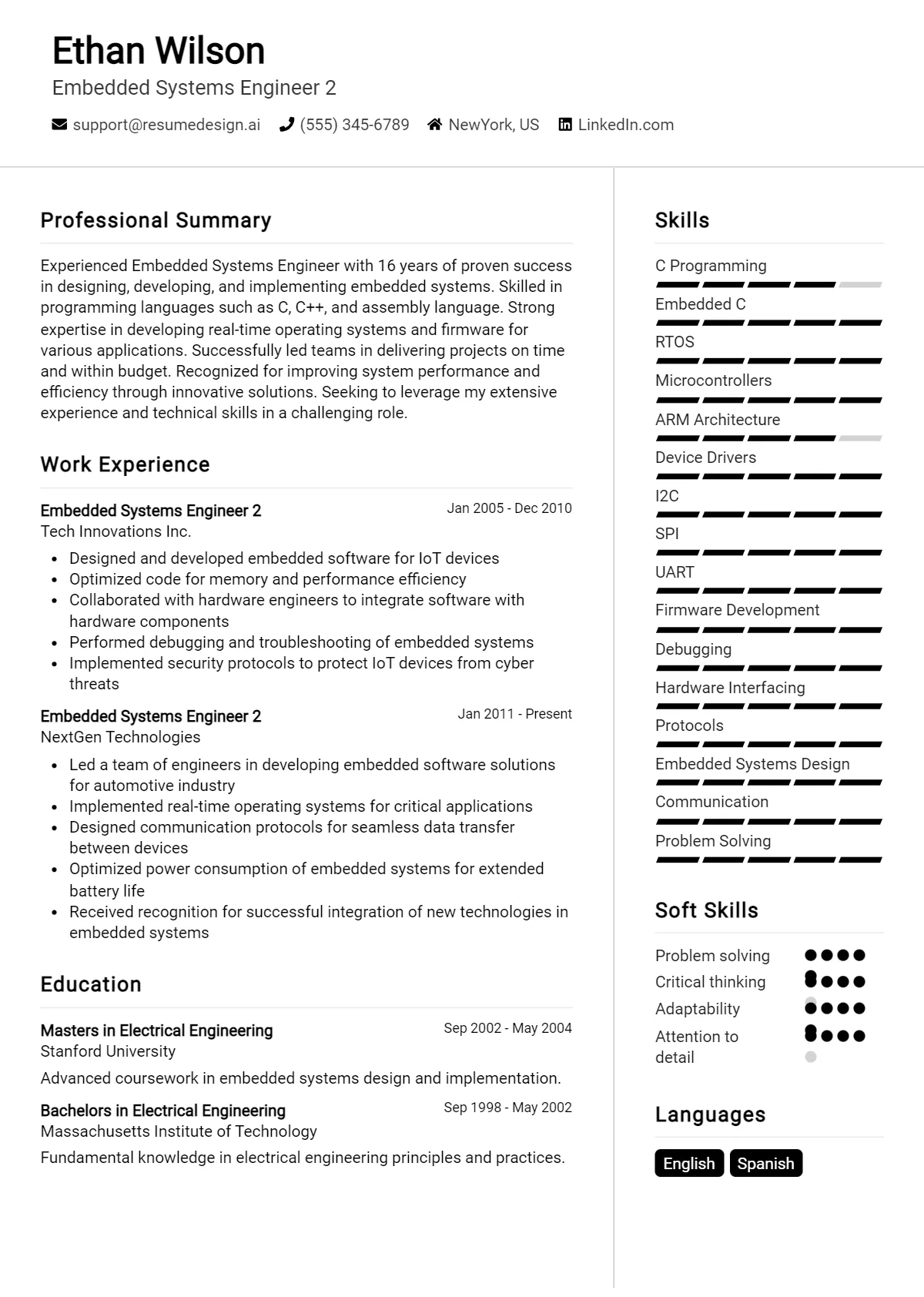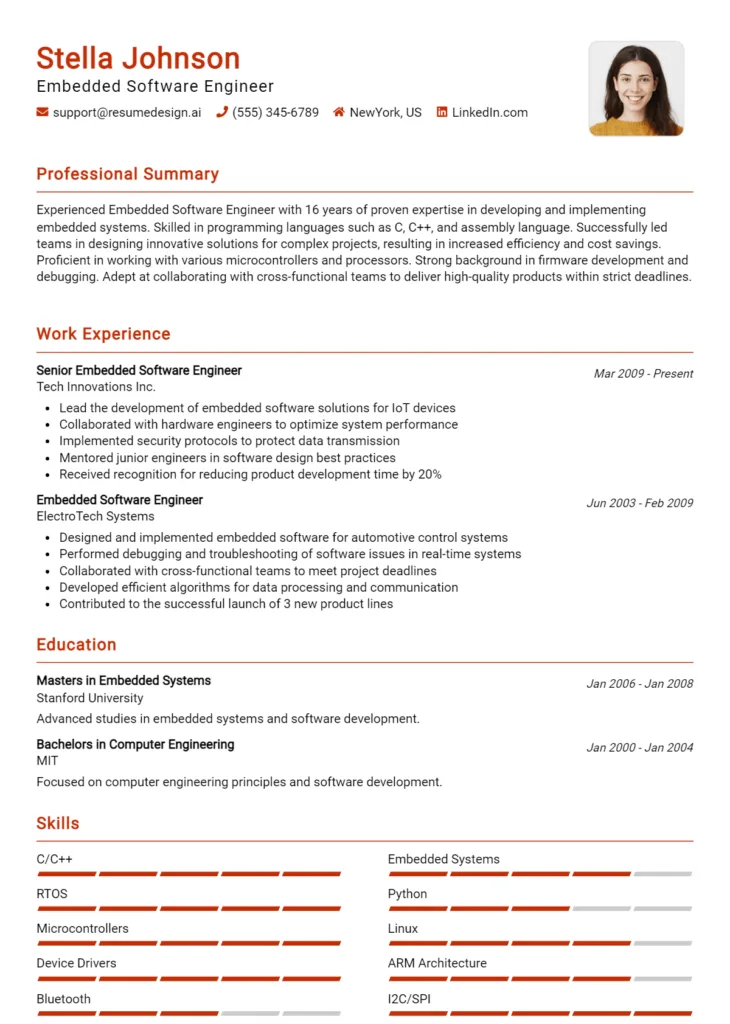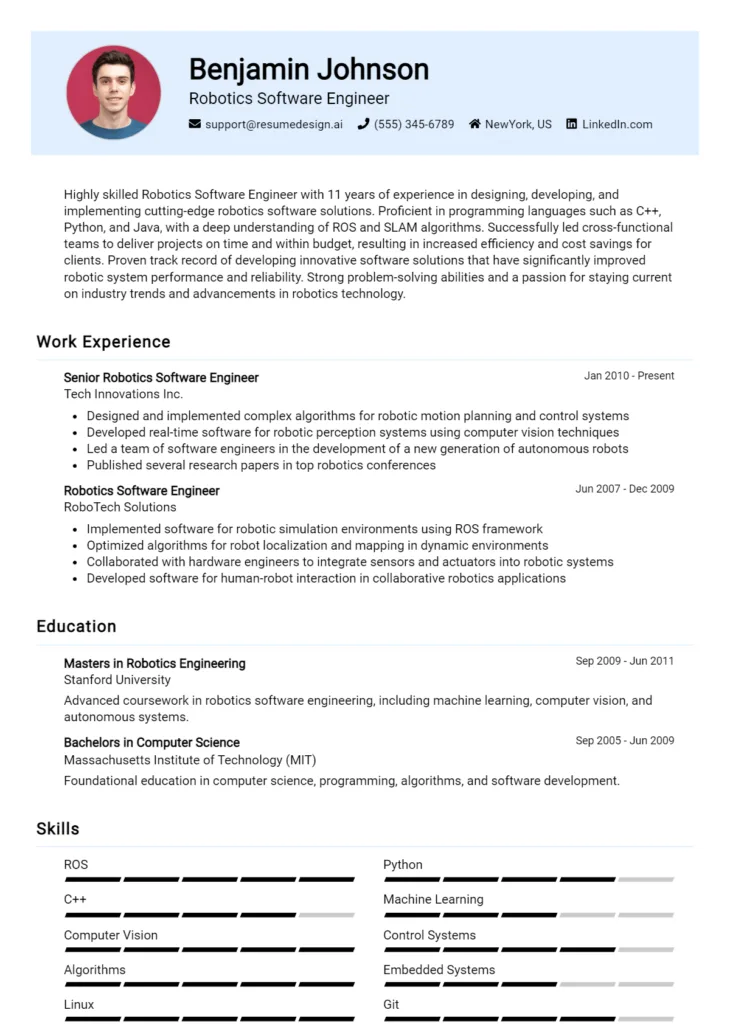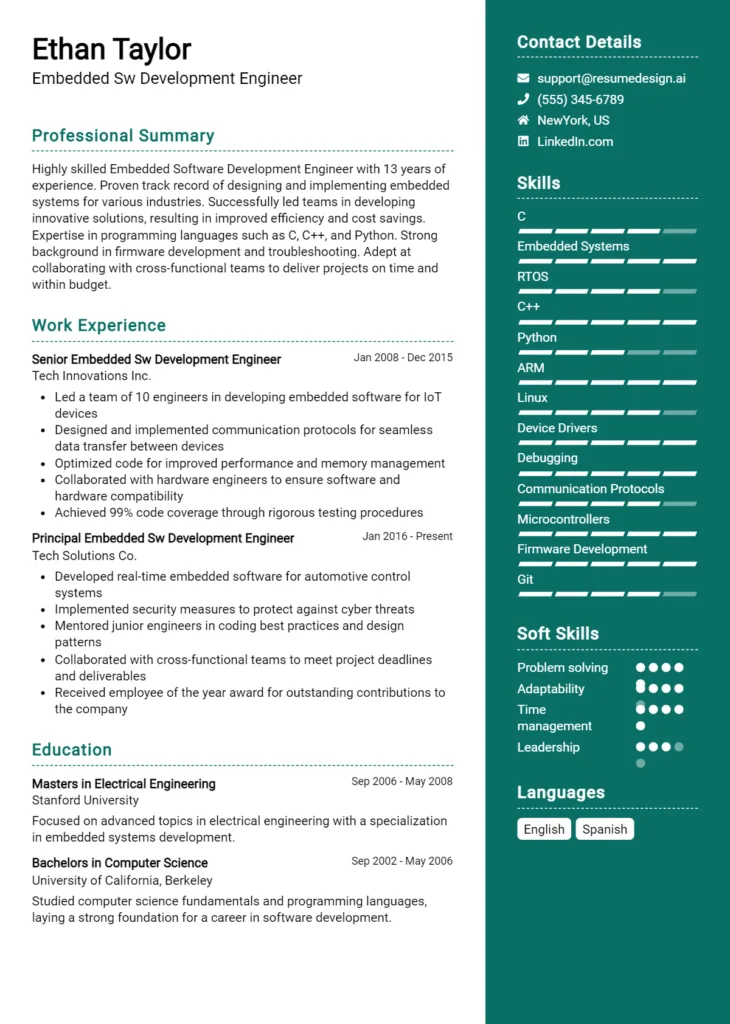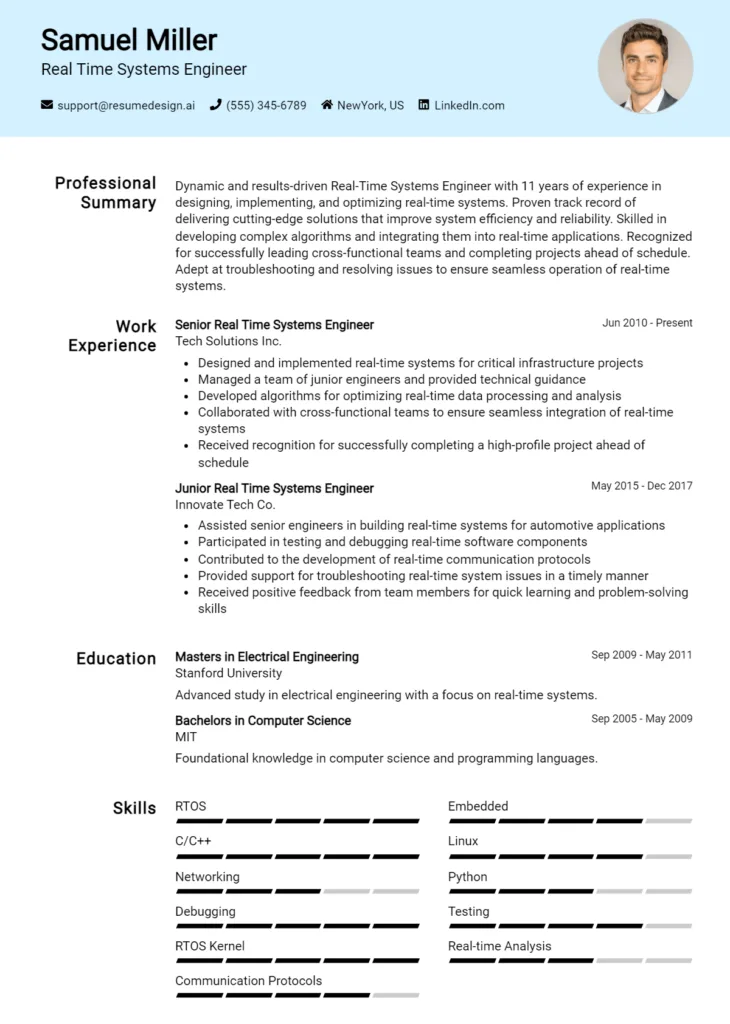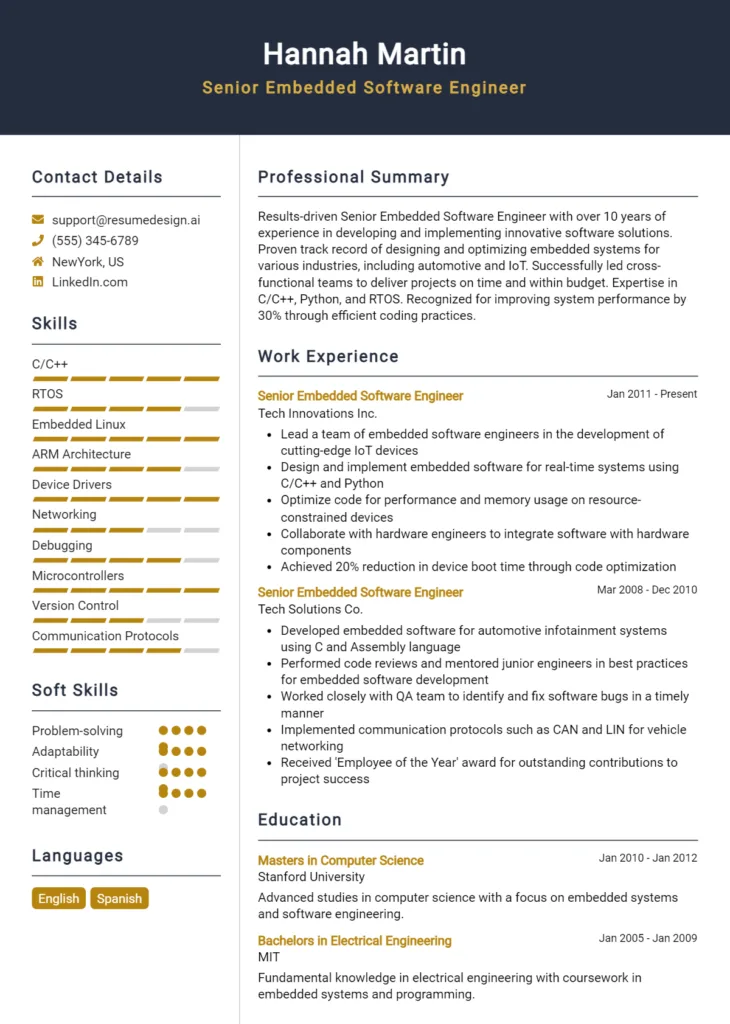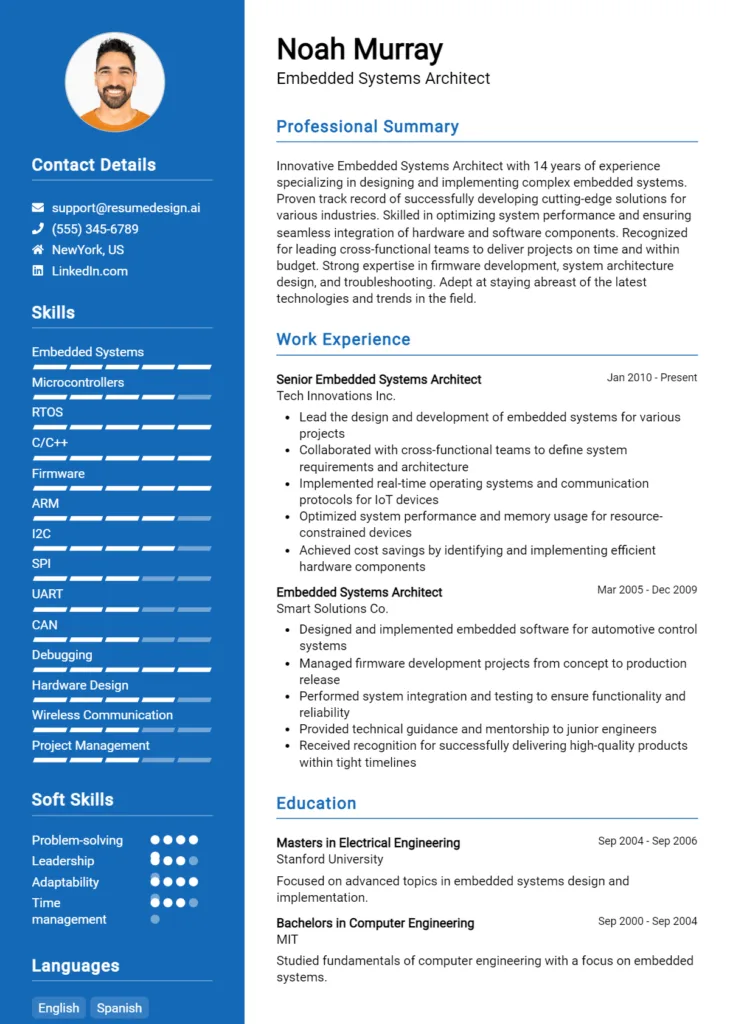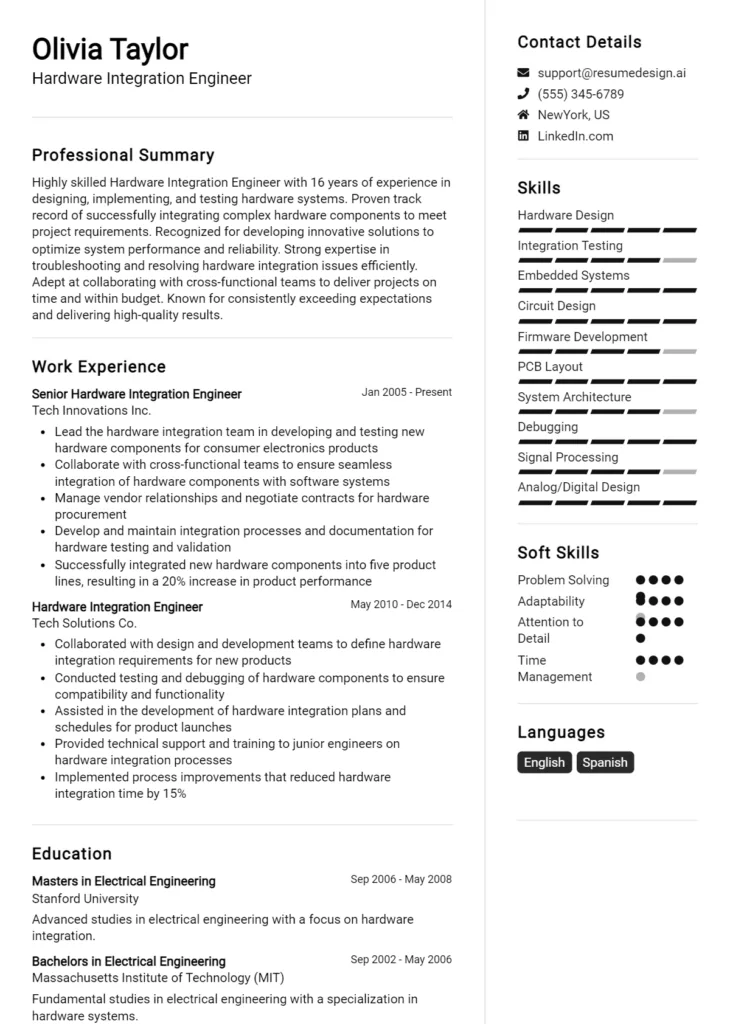Embedded Systems Engineer Core Responsibilities
An Embedded Systems Engineer is pivotal in designing and developing software and hardware solutions that integrate seamlessly into larger systems. Key responsibilities include collaborating with cross-functional teams, analyzing system requirements, and troubleshooting complex issues. Essential skills encompass technical expertise in programming languages, operational proficiency in embedded platforms, and strong problem-solving capabilities. These competencies enable engineers to contribute significantly to organizational goals, ensuring efficient product development. A well-structured resume will effectively highlight these qualifications, showcasing a candidate's potential for success.
Common Responsibilities Listed on Embedded Systems Engineer Resume
- Designing and implementing embedded software for various applications.
- Conducting system-level testing and debugging of hardware and software components.
- Collaborating with hardware engineers to define system architecture.
- Optimizing embedded systems for performance and power consumption.
- Documenting design processes and maintaining project specifications.
- Participating in code reviews and ensuring adherence to coding standards.
- Developing and maintaining firmware for embedded devices.
- Integrating communication protocols and interfaces in embedded systems.
- Analyzing and resolving technical issues throughout the product lifecycle.
- Staying updated with industry trends and emerging technologies.
High-Level Resume Tips for Embedded Systems Engineer Professionals
In the competitive field of embedded systems engineering, a well-crafted resume is crucial for making a strong first impression on potential employers. As candidates often face stiff competition, their resumes serve as the initial gateway to showcase not only their technical skills but also their unique achievements and experiences. A resume that effectively highlights relevant expertise in embedded systems, hardware-software integration, and problem-solving capabilities can set a candidate apart from the rest. This guide will provide practical and actionable resume tips specifically tailored for embedded systems engineer professionals, helping you create a document that resonates with hiring managers and encapsulates your professional journey.
Top Resume Tips for Embedded Systems Engineer Professionals
- Tailor your resume for each job application by carefully analyzing the job description and incorporating relevant keywords.
- Highlight your experience with embedded programming languages such as C, C++, and assembly language, focusing on specific projects where you applied these skills.
- Quantify your achievements by including metrics, such as performance improvements, cost savings, or project completion times.
- Showcase your familiarity with hardware platforms and development tools, such as microcontrollers, FPGAs, and debugging software.
- Include relevant certifications or training that underscore your expertise in embedded systems, like Certified Embedded Systems Engineer (CESE) or similar credentials.
- Demonstrate your problem-solving skills by providing examples of challenges faced during projects and how you overcame them.
- Use clear and concise language, avoiding jargon unless it is widely recognized in the embedded systems community.
- Incorporate a dedicated section for projects, detailing personal or professional projects that showcase your technical abilities and creativity.
- Keep the layout clean and professional, using bullet points and headings to enhance readability and draw attention to key information.
- Ensure that your resume is error-free, as even minor mistakes can convey a lack of attention to detail, which is crucial in this field.
By implementing these tips, embedded systems engineers can significantly increase their chances of landing a job in this dynamic field. A focused and strategically crafted resume not only highlights your technical skills and achievements but also demonstrates your commitment to presenting yourself professionally. With the right approach, your resume can open doors to exciting career opportunities in embedded systems engineering.
Why Resume Headlines & Titles are Important for Embedded Systems Engineer
In the competitive field of embedded systems engineering, a well-crafted resume headline or title serves as the first impression a candidate makes on hiring managers. It is crucial because it encapsulates a candidate's key qualifications and expertise in a concise manner, allowing them to stand out among a sea of applicants. A strong headline can immediately grab attention, providing a snapshot of the applicant's skills and relevant experiences while setting the tone for the rest of the resume. Therefore, crafting a title that is not only relevant but also impactful is essential for any embedded systems engineer looking to secure an interview.
Best Practices for Crafting Resume Headlines for Embedded Systems Engineer
- Keep it concise: Aim for a headline that is brief yet informative, ideally one line long.
- Be role-specific: Tailor the headline to reflect the specific position you are applying for.
- Highlight key skills: Include technical skills or specializations that are relevant to embedded systems engineering.
- Use impactful language: Choose strong, action-oriented words that convey expertise and confidence.
- Avoid jargon: Use clear language that can be understood by hiring managers, not just technical experts.
- Showcase accomplishments: If possible, reference notable achievements that demonstrate your capabilities.
- Incorporate keywords: Use industry-specific keywords that align with the job description to enhance visibility.
- Make it unique: Differentiate yourself by avoiding clichéd phrases that may blend in with other resumes.
Example Resume Headlines for Embedded Systems Engineer
Strong Resume Headlines
"Innovative Embedded Systems Engineer with 5+ Years of Experience in IoT Solutions"
“Expert in Real-Time Operating Systems and Firmware Development for Automotive Applications”
“Results-Driven Embedded Engineer Specializing in Low-Power Design and Optimization”
“Dedicated Embedded Systems Engineer with Proven Track Record in Product Development and Testing”
Weak Resume Headlines
“Engineer Looking for Opportunities”
“Embedded Systems Professional”
The strong headlines are effective because they not only convey the candidate's specific skills and experience but also align closely with the responsibilities and requirements of the role. They demonstrate a clear understanding of what hiring managers are looking for. In contrast, the weak headlines fail to impress due to their vagueness and lack of specificity. They do not offer any insight into the candidate's unique strengths or how they can contribute to the organization, making them easily forgettable in a competitive job market.
Writing an Exceptional Embedded Systems Engineer Resume Summary
A well-crafted resume summary is crucial for an Embedded Systems Engineer, as it serves as the first impression a hiring manager has of a candidate. This brief yet powerful section quickly captures attention by showcasing essential skills, relevant experience, and notable accomplishments that align with the job requirements. A strong summary is concise and impactful, providing a snapshot that encourages further reading. It should be tailored to the specific position, highlighting the candidate's unique qualifications that make them an ideal fit for the role.
Best Practices for Writing a Embedded Systems Engineer Resume Summary
- Quantify achievements: Use specific numbers or percentages to demonstrate your impact in previous roles.
- Focus on relevant skills: Highlight technical skills and tools that are pertinent to embedded systems engineering.
- Tailor the summary: Customize your summary for each job application to reflect the specific requirements and keywords from the job description.
- Keep it concise: Aim for 3-5 sentences that clearly articulate your strengths without unnecessary fluff.
- Highlight key accomplishments: Mention any awards, certifications, or successful projects that showcase your expertise.
- Use action verbs: Start sentences with strong action verbs to convey confidence and proactivity.
- Showcase problem-solving abilities: Emphasize your experience in troubleshooting and optimizing embedded systems.
- Maintain professionalism: Use a formal tone and avoid overly casual language to maintain a professional demeanor.
Example Embedded Systems Engineer Resume Summaries
Strong Resume Summaries
Results-driven Embedded Systems Engineer with over 5 years of experience in designing and implementing high-performance embedded solutions. Led a team project that improved system performance by 30%, resulting in a 20% reduction in energy consumption. Proficient in C/C++, Python, and RTOS, with a proven track record of delivering projects on time and within budget.
Innovative Embedded Systems Engineer with a solid background in developing firmware for IoT devices. Successfully reduced product time-to-market by 25% through agile methodologies and effective cross-functional collaboration. Skilled in hardware-software integration and troubleshooting complex systems.
Detail-oriented Embedded Systems Engineer with expertise in low-level programming and circuit design. Achieved a 40% decrease in system downtime by implementing real-time monitoring solutions. Adept at using tools such as MATLAB and LabVIEW to optimize embedded applications.
Weak Resume Summaries
Embedded Systems Engineer with some experience in the field. I am looking for a new opportunity where I can contribute my skills.
Motivated engineer with a background in embedded systems. I have worked on various projects and am ready for a new challenge.
The strong resume summaries stand out because they provide specific achievements and quantifiable results, demonstrating the candidate's impact and expertise in the field. They also clearly highlight relevant skills and experiences tailored to the role of an Embedded Systems Engineer. In contrast, the weak summaries are vague and lack specificity, making them less impactful and memorable, which can lead to missed opportunities in a competitive job market.
Work Experience Section for Embedded Systems Engineer Resume
The work experience section is a critical component of an Embedded Systems Engineer resume, as it serves as a showcase for the candidate's technical skills, project management capabilities, and commitment to delivering high-quality products. This section not only provides potential employers with insights into the candidate's hands-on experience but also highlights the practical application of their knowledge in real-world scenarios. By quantifying achievements and aligning work experiences with industry standards, candidates can effectively demonstrate their value and impact within the field of embedded systems engineering.
Best Practices for Embedded Systems Engineer Work Experience
- Use clear, concise language to describe your technical expertise and relevant projects.
- Quantify your achievements with specific metrics, such as reduced costs or improved efficiency.
- Highlight leadership roles and teamwork experiences that emphasize collaboration.
- Tailor your experiences to align with the requirements of the job you're applying for.
- Include relevant technologies and tools you have utilized in your work.
- Showcase problem-solving capabilities by detailing challenges faced and solutions implemented.
- Emphasize continuous learning and adaptation to new technologies in your work history.
- Utilize action verbs to convey your contributions and responsibilities effectively.
Example Work Experiences for Embedded Systems Engineer
Strong Experiences
- Led a team of 5 engineers to develop an IoT device that reduced power consumption by 30%, resulting in annual savings of $50,000.
- Designed and implemented firmware for a medical device, achieving FDA approval within 6 months of project initiation.
- Collaborated with cross-functional teams to optimize a real-time operating system, improving system response time by 25%.
- Managed the software development lifecycle for a smart home product, successfully launching it to market three months ahead of schedule.
Weak Experiences
- Worked on various projects that involved coding and testing.
- Participated in team meetings to discuss project updates.
- Assisted with debugging and troubleshooting of embedded systems.
- Helped in the development of software for a product.
The strong experiences are considered effective because they clearly quantify achievements, demonstrate leadership, and highlight specific contributions to projects, making them impactful and relevant to potential employers. In contrast, the weak experiences lack detail and measurable outcomes, making them less compelling and failing to convey the candidate's true capabilities in embedded systems engineering.
Education and Certifications Section for Embedded Systems Engineer Resume
The education and certifications section of an Embedded Systems Engineer resume is crucial as it serves to showcase the candidate's academic background and commitment to professional development. This section not only highlights relevant degrees and specialized training but also emphasizes industry-recognized certifications that can set a candidate apart in a competitive job market. By providing details on relevant coursework and continuous learning efforts, candidates can enhance their credibility and demonstrate their alignment with the specific demands of the Embedded Systems Engineer role, thereby increasing their chances of standing out to potential employers.
Best Practices for Embedded Systems Engineer Education and Certifications
- Include only relevant degrees that align with embedded systems engineering, such as Electrical Engineering or Computer Engineering.
- Highlight industry-recognized certifications, such as Certified Embedded Systems Engineer (CESE) or similar credentials.
- List relevant coursework that directly pertains to embedded systems, such as microcontroller programming, real-time operating systems, and digital signal processing.
- Use clear formatting to make the section easy to read, ensuring degrees and certifications are easily identifiable.
- Include the dates of completion for degrees and certifications to showcase ongoing education.
- Provide details on any specialized training or workshops attended that are pertinent to embedded systems.
- Focus on achievements or projects completed during education that demonstrate practical application of skills.
- Keep the section concise but comprehensive, avoiding clutter with non-relevant information.
Example Education and Certifications for Embedded Systems Engineer
Strong Examples
- Bachelor of Science in Electrical Engineering, University of Technology, Graduated May 2022
- Certified Embedded Systems Engineer (CESE), Issued December 2022
- Relevant Coursework: Microcontroller Programming, Digital Signal Processing, and Real-Time Systems.
- Completed Advanced Embedded Systems Training Workshop, August 2023
Weak Examples
- Associate Degree in General Studies, Community College, Graduated June 2020
- Certification in Basic Computer Skills, Issued January 2021
- Relevant Coursework: Introduction to Literature and Art History.
- Completed Online Course in Social Media Marketing, February 2022
The strong examples are considered effective as they directly relate to the field of embedded systems engineering, showcasing relevant degrees, certifications, and coursework that align with industry standards. In contrast, the weak examples illustrate qualifications that are either irrelevant to the role or do not demonstrate a commitment to the specific technical skills and knowledge required for an Embedded Systems Engineer, thereby diluting the candidate's qualifications in the eyes of potential employers.
Top Skills & Keywords for Embedded Systems Engineer Resume
As an Embedded Systems Engineer, showcasing your skills on your resume is crucial for standing out in a competitive job market. Employers seek candidates who not only possess the technical know-how but also demonstrate the interpersonal abilities essential for successful collaboration within diverse teams. A well-crafted resume that highlights both hard and soft skills can significantly enhance your chances of landing an interview. By emphasizing your qualifications, you create a compelling narrative of your capabilities, making it easier for hiring managers to envision you as a valuable asset to their organization.
Top Hard & Soft Skills for Embedded Systems Engineer
Soft Skills
- Problem-solving
- Team collaboration
- Communication skills
- Adaptability
- Attention to detail
- Time management
- Critical thinking
- Creativity
- Project management
- Leadership
Hard Skills
- C/C++ programming
- Microcontroller programming
- Real-time operating systems (RTOS)
- Embedded Linux
- Circuit design and analysis
- Hardware/software integration
- Debugging and troubleshooting
- Signal processing
- Communication protocols (e.g., I2C, SPI, UART)
- Firmware development
Highlighting these skills along with your relevant work experience will help create a comprehensive view of your capabilities as an Embedded Systems Engineer.
Stand Out with a Winning Embedded Systems Engineer Cover Letter
Dear Hiring Manager,
I am writing to express my strong interest in the Embedded Systems Engineer position at [Company Name], as advertised on [Job Board/Company Website]. With a solid foundation in electrical engineering combined with extensive experience in embedded systems design and development, I am excited about the opportunity to contribute to your team and help drive innovative solutions. My hands-on experience with various microcontrollers and real-time operating systems has equipped me with the skills necessary to tackle complex problems and deliver high-quality, reliable products.
Throughout my career, I have successfully led multiple projects that involved designing, implementing, and testing embedded systems for diverse applications, including consumer electronics and automotive systems. My proficiency in C/C++ programming, along with my understanding of hardware-software integration, has enabled me to optimize system performance and enhance functionality. At [Previous Company Name], I played a key role in a project that reduced system latency by 30% through efficient coding practices and meticulous debugging, showcasing my ability to improve product performance while adhering to strict deadlines.
In addition to my technical skills, I pride myself on my ability to collaborate effectively with cross-functional teams. I believe that effective communication is crucial in the development process, and I have a proven track record of working closely with hardware engineers, software developers, and project managers to ensure seamless integration and successful project completion. I am particularly drawn to [Company Name] because of its commitment to innovation and excellence in embedded systems technology, and I am eager to contribute my expertise to your team.
Thank you for considering my application. I am looking forward to the opportunity to discuss how my skills and experiences align with the goals of [Company Name]. I am excited about the possibility of contributing to your innovative projects and helping the company maintain its leadership in the industry. Please feel free to contact me at your earliest convenience to schedule a conversation.
Sincerely,
[Your Name]
[Your Phone Number]
[Your Email Address]
Common Mistakes to Avoid in a Embedded Systems Engineer Resume
When crafting a resume as an Embedded Systems Engineer, it's crucial to present your skills and experiences effectively to stand out to potential employers. Many candidates, however, fall into common pitfalls that can undermine their qualifications. Avoiding these mistakes can significantly enhance the chances of landing your desired position in this competitive field. Here are some prevalent errors to steer clear of:
Overloading with Technical Jargon: While technical skills are essential, using excessive jargon can make your resume difficult to read for HR personnel who may not have a technical background. Aim for clarity and conciseness.
Neglecting Soft Skills: Focusing solely on technical abilities often leads to the omission of vital soft skills such as teamwork, communication, and problem-solving, which are crucial in collaborative environments.
Lack of Tailoring: Submitting a generic resume for every application can diminish your chances. Tailor your resume to highlight relevant experiences and skills that match the specific job requirements.
Ignoring Formatting: A cluttered or inconsistent format can distract from your qualifications. Ensure your resume is well-organized with clear headings, bullet points, and consistent font usage for readability.
Omitting Relevant Projects: Failing to include personal or academic projects that demonstrate your hands-on experience with embedded systems can be a missed opportunity to showcase your practical skills.
Vague Descriptions: Using vague language when describing your responsibilities and achievements can leave employers unclear about your contributions. Be specific about your roles and quantify your accomplishments when possible.
Inadequate Education or Certification Details: Not highlighting relevant educational background or certifications can lead to missed opportunities. Include details about your degrees, relevant courses, and any certifications that enhance your qualifications.
Ignoring Keywords: Many companies use Applicant Tracking Systems (ATS) to filter resumes. Failing to incorporate relevant keywords from the job description can result in your resume being overlooked. Use industry-specific terms to increase your chances of passing the ATS screening.
Conclusion
As an Embedded Systems Engineer, you play a crucial role in designing and developing software and hardware systems that operate within embedded environments. The key skills you should highlight in your resume include proficiency in programming languages such as C and C++, experience with microcontrollers and embedded systems architectures, and familiarity with real-time operating systems (RTOS). Additionally, showcasing your problem-solving abilities, teamwork experience, and understanding of hardware-software integration can significantly enhance your candidacy.
It’s important to tailor your resume to reflect not only your technical skills but also your project experiences and achievements in previous roles. Consider including specific metrics and outcomes of your work to demonstrate your impact.
To ensure your resume stands out in a competitive job market, take advantage of the available resources. Explore resume templates to create a professional layout that highlights your expertise effectively. Utilize the resume builder for a streamlined approach to crafting your resume. Additionally, reviewing resume examples can provide inspiration and guidance on how to structure your document. Don’t forget to prepare a compelling cover letter using cover letter templates to complement your resume.
Take the time to review and refine your Embedded Systems Engineer resume today—it could be the key to unlocking your next career opportunity!

